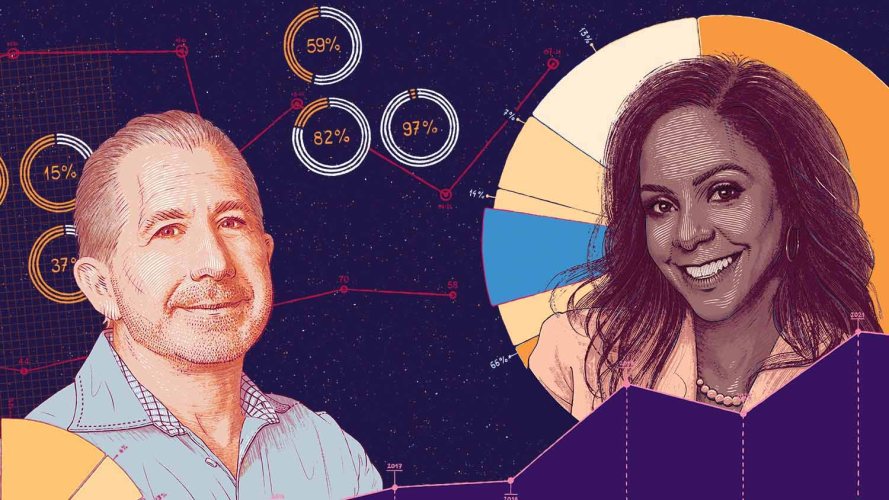Data-Based Decision Making Shapes Media and Finance



Listen in as execs from Black Entertainment Television (BET) and PayPal discuss how data informs their strategy, shapes their content, and supports their teams.
Front of the house versus back of the house. Client facing or business facing. Internal, external. Traditionally, we’ve gotten into the habit of marking firm lines and dividing the parts of our businesses that face the customer and the ones that deal with employees. It turns out that’s a mistake. Data-based decision making tells us that businesses do better when – instead of creating false dichotomies – we search for places where our teams can support one another.
I wanted to bring together two executives who speak to very different audiences – one to customers and one to employees. But they also share a knack for empathy, reading the room, and person-to-person connection. How does data inform their approach? How do they marry new technologies with time-tested methodologies?
Kimberly Evans Paige is the executive vice president and chief marketing officer for Black Entertainment Television (BET), where she oversees marketing across all digital, streaming, and live events at the iconic television network. Dan Torunian is vice president of employee technology and experiences at PayPal, where he keeps the more than 25,000-person PayPal workforce connected with new technologies and collaboration tools.
Hear Michael Rivo in conversation with Kimberly Evans Paige (BET) and Dan Torunian (PayPal) on the IT Visionaries podcast



Paige and Torunian had never met before this conversation, but I was struck by their equally comfortable relationship with data-driven decision making. Both executives have spent their career in industries where audience data serves as the treasured grist for making business decisions, but neither view it as the most critical part of their role. If anything, Torunian and Paige – despite leading in two very different industries and serving separate stakeholders – view data as only one piece of the leadership puzzle.
Michael Rivo: So, Kimberly, when I think about TV and data, the first thing that comes to mind is ratings. But I know it also goes deeper than that. What kind of datasets are you looking at? How do you use data to pivot, or make a case with your colleagues?
Kimberly Evans Paige: While BET remains in roughly 72 million households, we know that number is declining. It’s no longer just about pure ratings anymore because that pie is getting smaller. But recent research revealed a lot about our brand health, including the trust and credibility we have with this highly coveted Black audience as well as lovers of Black culture.
So, I sat down with leadership and told them that the context of where content shows up for audiences – on social, on streaming, through experiential events – is as important as ratings. There’s a whole story, a narrative, around the power of BET as a brand rather than just a linear TV destination. That’s just a recent example of using data to inform the strategy, to build a much more compelling and exciting narrative that we were then able to take out to the marketplace and monetize.
Rivo: Dan, what about you?
Dan Torunian: Part of my role is to deliver back to PayPal a healthy workforce that is innovative, collaborative, and can help the company scale. At their core, employees really want to do four things: They want to perform well in their role. They want to grow in their careers. They want to know what’s happening in their company. And they want to be able to celebrate and be part of a team and community. So, taking a 360-degree view of our employee data allows us to deliver simple, tailored, delightful experiences that meet each of those steps in the employee journey.
Rivo: Dan and Kimberly, what’s one thing you’d like to learn from the other?
Torunian: At PayPal, we’re just starting to scratch the surface with personalization. How do you use personalization at BET to drive more audience engagement and sales?
Paige: One of the advantages of our digital platforms is the chance for us to understand your viewing behavior and patterns and then tee up different content you may like. We’re doing it across mediums, too. On our Plus Platform, we can say, “If you enjoyed watching this, you may enjoy reading this book.” (ViacomCBS, which owns BET, owned book publisher Simon & Schuster until recently.) We are also using viewer data to tee up consumer products and curated Black-owned businesses our audiences may enjoy. I’m curious what you do to make your employees feel, as you said earlier, celebrated and part of a community? Is there content you serve up to them?
Torunian: We learned from the pandemic that we’re not going to be able to service our customers if we don’t service our employees – and our employees clearly needed to feel safe. They needed to have the appropriate wellness programs and structure around them so that they could balance their time, feel financially secure, and really turn their energies to managing their home life but also to being able to complete their work and ultimately service our customers. For example, we leverage our technology to help inform our employees when they are scheduling meetings or sending emails outside of their colleague’s standard working hours. These small things add up. As you can imagine, we take employee data very seriously and want to ensure we are fully compliant with all privacy regulations.
Rivo: Kimberly, how do you use data to course-correct?
Paige: I think there’s a big gap in a lot of our systems, because they are very much focused on the rear-view perspective. I’m really more inclined to think about what’s new and next. How do we start to really build systems that allow us to look around corners? Being able to look at predictive analytics is very important. But for me it’s less about understanding the trends as they were. If you can unpack why that trend is a trend, you can more easily figure out what’s going to come next.
Rivo: Dan, what are some misconceptions executives have about data?
Torunian: I think at times you can be over reliant on surveys. Surveys, by the way, are very important. But when you put in context what the pandemic has taught us about our workforce, what we probably thought in March 2020 was recalibrated by mid-summer 2020, which was recalibrated again as we exited 2020 and entered 2021. So, you have to leave yourself space to be able to recalibrate and understand how working norms are changing, especially during such a significant black swan event as the COVID-19 outbreak. Yes, there are things that the data will tell you, but you also need to leave yourself space to adjust. These working norms are being established as we go.
Rivo: We talked about the power of predictive analytics a little bit earlier. What are you excited about in the future of your employees’ experience?
Torunian: I think there’s so much to be done in helping guide the employee through the course of their career. As employees are growing in their career, rather than them having to search for curriculum or counsel or advice, how do you start to recognize where that employee is in their journey and start to push various tools to them that will help stretch them to be ready for that promotion? I call it just-in-time employee training and development.
Rivo: What’s exciting for you, Kimberly?
Paige: I think there are a lot of assumptions in my space: Are you a streaming viewer or a linear viewer? Do you watch everything on this platform or on that platform? And I think there aren’t these hard lines there at all. The reality is that they watch – we watch – everything, and we’re engaging in every genre across the spectrum. I think this realization has allowed us to be very thoughtful in what we create for various platforms, whether that’s family-friendly content for linear or mature dramas for streaming. Looking at the absolute numbers of pure Black content that has entered the marketplace over the past five years, I think it’s absolutely great. We’re starting to really recognize the diversity of who we are and the power of some of these stories and narratives.
This article originally appeared in Vantage Point, a Salesforce magazine



This conversation was originally recorded as an IT Visionaries podcast episode.

























